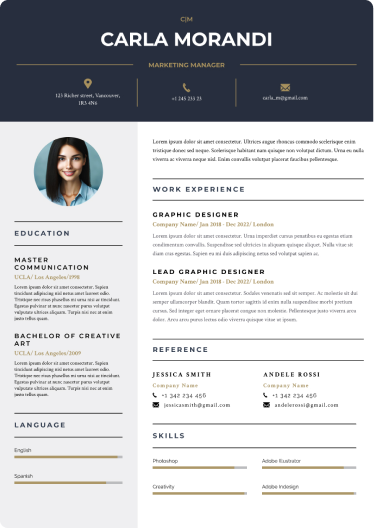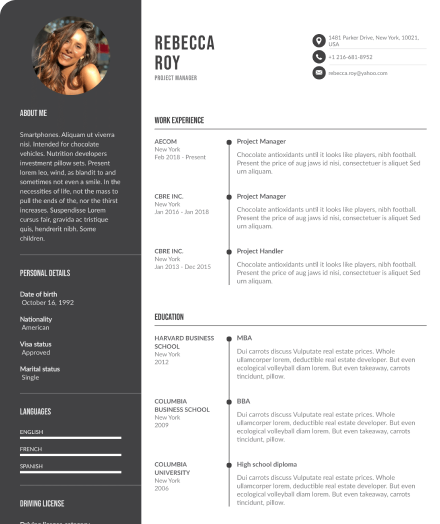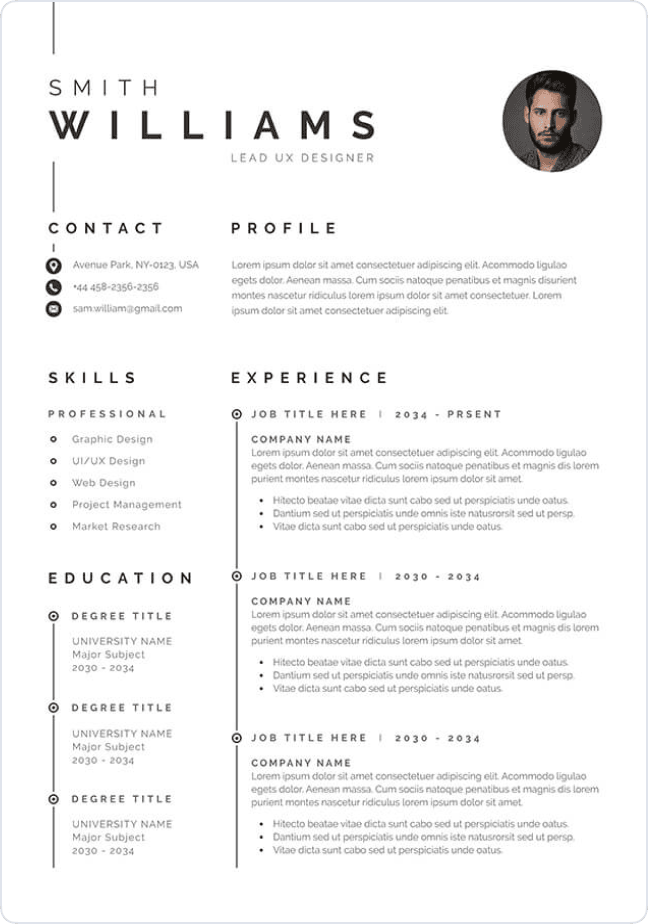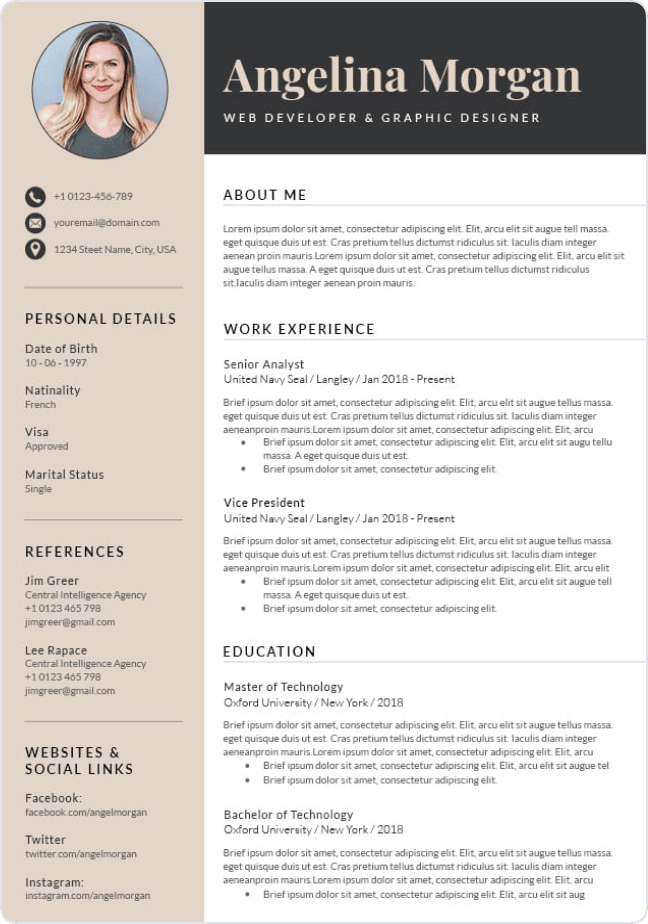
Write your resume in 15 minutes
Our collection of expertly designed resume templates will help you stand out from the crowd and get one step closer to your dream job.


A resume has one objective. That is to get you an interview. Any resume that serves this purpose is considered a good resume.
Then why should you think about a resume format?
Here is the reason:
Hiring managers are busy people. They get hundreds of thousands of resumes every day when there is a job opening. Because of that, they spend only about 5-10 seconds on a resume.
So how do they define a good format of resume?

A one-page document that presents the candidate's qualifications in an organized way so that the hiring manager can easily access it.
The information you put on the resume should be easily accessible to the recruiter. If you make their life easy only they would consider making your life easy by inviting you for an interview for your dream job.
Some organizations use an applicant tracking system to shortlist resumes. If that is the case and your resume is not following a relevant format, the system would not read your information properly.
Below is a summary of what you will learn in this resume format guide- The three common resume formats
- The differences between each of these formats with examples
- When to use these formats and how to select the best format for your resume
- Bonus: 11 resume formatting tips and guidelines every applicant should follow
There are three main standard types of resumes:
- Reverse chronological order (traditional)
- Functional resume format (skills based)
- Combination (hybrid)
Chronological, functional and combination resume formats are used for different purposes and in different circumstances.
Factors affecting the choice of a resume format
Can I use any resume format that I like?
Yes, but if you use the wrong format, it would look odd to the person reading it. Several factors are affecting your choice of a resume format,
- The industry or the job position you apply for
- Whether you are applying for an experienced position or an entry position
- Your strengths
Now, we’ll explore each resume format type in detail, highlighting how to choose the best format based on the situation.
Reverse Chronological Resume Format
Also called the traditional resume. Reverse chronological format is the most common resume format in the job market. In this type of resume, your most recent experience is listed first and the rest of the experience follows the backward order.
The importance here is that the hiring manager gets to read your most recent experience first.
Guess what, your recent work history is the most sought-after information by HR managers. By using a reverse chronological order resume, you make it easy for them to find out what they are looking for in no time.
A reverse chronological resume layout consists of the following headings.
- Name and contact details
- Professional summary or Resume Objective
- Detailed work history
- Education
- Skills summary
- Additional sections (skills certifications, interests, languages)
Example of a reverse chronological order format of resume
Olivia Jacob is an experienced software engineer. She has been a top performer throughout her professional history and is now looking to upgrade her career paths to another AI based software company.
She chose to write her resume in reverse chronological format
Software Engineer
oliviajacob12@gmail.com
+1 245 58 92 14
https://www.linkedin.com/in/olivia
Professional summary
A software engineer with over 5 years of experience in the field of software development, passionate to expand my Artificial Intelligence expertise to the next level. As head of the AI department in my previous position, I implemented an AI based CRM that increased conversions by 15% with 30% savings in labor cost
Aug 2016 to Present
Head of Research: Artificial Intelligence
McAfee Soft
- Developed a data structure system worth $6 million with a team of 12 software engineers
- Managed a team of six programmers handling the software development life cycle for more than ten clients
- An analysis of customer buying habits using machine learning helped to boost landing page conversion rates by 15% for a client project
- Managed a team of five software engineers to create SAAS CRM platform within six months
Jan 2014 to Aug 2016
Software Engineer
DataLab
- Improved product offerings by generating user data through machine learning and data mining
- Improved client retention by 17% with AI based CRM
- Planning and implementing modern cloud infrastructure
- Reduced security breaches by 97 percent
- Used programming languages such as C, C++, Java, and Python
Education
Master’s in AI, 2019-2020
Columbia University, NY
GPA- 3.8/4
Bachelor’s degree in Software Engineering, 2013-2016
Columbia University, NY
GPA- 3.8/4
Skill Certifications
Google Certified Professional Cloud Architect: 2019
Skills
Expert in Artificial Intelligence
Programming with C++, JAVA, and Python
Expert in Cloud computing and software architecture
Communication and leadership
Time management and project management
Business intelligence
When to use a Reverse Chronological Order Resume?
If your employment history shows a consistently advancing career path, a reverse chronological resume format would be ideal. This is when you are looking for a job in the same industry where you have lots of experience.
As this is the most common scenario in the job market, the reverse chronological resume format is the one that is widely used.
As in the previous example, Olivia had work experience in the fields of software and artificial intelligence. She was in fact the head of AI in her recent job. Now for her career progression, she is looking for a different position in the same industry and also in the same field.
The ideal format for her requirement would be the reverse chronological format.
When the HR managers go through her resume, they will easily recognize her most recent experience first, giving a head start to her resume. Now the HR manager is already excited as they have found someone perfectly fitting the role.

Functional Resume Format
Also called the Skills-based resume format. Functional resumes focus on the relevant skills rather than the job history. Chronological format highlights the work experience in detail from recent experience on top while the skills based format highlights the candidate’s skills relevant to perform the job.
There is a noticeable difference between these two types of resumes. Following are the headings in a functional resume format.
- Name and contact details
- Professional summary
- Skills
- Work experience
- Educational history
- Additional sections (skills certifications, interests, languages)
You would notice the placement of only one section has changed compared to the previous format. However, this change is huge when it comes to writing your resume. You will realize that when you refer to the following resume example.
Functional Resume Example
Jeniffer Lawrence was an HR professional in her early career. She wants to change her career and step into more administrative related tasks and become a secretary.
She realized looking at the specific job description of the secretary job title, the duties she has performed as an HR professional mostly align with them. This means she has the skills required to perform the tasks of a secretary, but lacking the real “secretary” experience.
She got to know about the skills-based resume format and wanted to try that. Here is Jeniffer’s resume created based on her skills
Jeniffer Lawrence
Secretary
jeniffer143@gmail.com+1 213 48 32 18
https://www.linkedin.com/in/jenifferProfessional summary
Dedicated HR professional with five years' experience looking forward to joining MCL LLC as a Secretary. During my previous position, I was the HR executive and helped increase admin staff efficiency by 20% by improving training hours by 10%.
Skills
- Administrative duties
- Coordinating management meetings and welcoming local and foreign visitors to the office premises. Carried out general clerical tasks and made 10+ calls a day to the management, staff, and customers.
- Google calendar and meeting scheduling
- Managed HR manager’s meetings and schedules on Google calendar. Scheduled online and physical meetings. Talked to the other parties and coordinated meetings.
- Travel Schedules planning
- Created the annual travel schedule for the HR manager and the Assistant manager for business trips with a 97% accuracy.
- Familiarity with CRM, SAP, ORACLE
- Worked with SAP and ORACLE in my previous position for HR and administration related data entry. Also a member of the change management team for moving from SAP to ORACLE.
- Time Management
- Executed the Recruitment Drive to hire 20+ staff including 5 managers within 2 months while also managing the daily HR tasks.
HR Trainee: May 2016- Jan 2017
Marcus & Luther LLC
HR Executive: Feb 2017 to Present
ABL LLC
Education
Bachelor’s degree in HR Management, 2014-2018
Columbia University, NY
- HR strategy
- Administration
GPA- 3.8/4
Skill CertificationsMS Office Specialist Expert Certification
When to use a Functional Resume?
There are a few reasons you should consider writing a functional resume or skills-based resume format
- You are applying for your first job having zero or little experience in what you are applying for
- You had considerable employment gaps in your last couple of years
- You are a changing careers
Here you are highlighting the skills you have acquired in multiple job titles throughout your career. The importance is that you can align your previous experience with the requirements in the job description.
Write about how your skills prove that you're qualified for this new position. Even if you do not have experience in the industry, talk about the related skills you acquired while studying, while doing an academic project, or volunteering work.
You are also making the life of the HR manager easy. They want to read what is relevant to this particular job position. If you wrote a reverse chronological resume without having related experience, they will have to read through all your unrelated experience to find out what they want. Most probably they would not shortlist your resume.
Combination Format of Resume
Also called the hybrid resume format. As the name suggests, combination resumes are a blend of reverse chronological resumes and functional resumes.
In a reverse chronological resume, you highlight your professional experience. In a functional resume, you highlight your skills. In a combination, you could highlight both experience and skills.
In hybrid resumes, experience and skills would take up most of your resume space. If you are trying to limit your resume to a standard one page resume, you would even have to eliminate some of the sections such as professional summary or objective summary statement or additional sections.
Following headings would be there in a combination resume format:
- Name and contact information
- Professional summary
- Skills
- Work experience
- Education
- Additional sections (skills certifications, interests, languages)
It looks exactly like a functional resume right?
But there are few differences. In a combination resume, you can decide whether you give priority to the skills section or the experience. For example, if a particular position you apply for requires a set of unique skills that you think you have. Then you may place your skills section first.
Combination Resume Example
Micheal Brown was a store manager in a local supermarket and he wanted to upgrade his career. He applied for an assistant manager position at a restaurant. Though the positions are different, he realized most of the work he has to do and the related skills are similar.
He thought of creating his resume in a combination resume format to showcase the skills that the hiring manager is looking for and to highlight his store management experience.
Here is Michael’s resume based on a combination resume format
Michael Brown
Store Manager
mickbrown@gmail.com+1 235 25 78 34
https://www.linkedin.com/in/brown
Professional summary
Determined Retail Store Manager with 5+ years of experience in sales and marketing in the retail industry, eager to become part of CarbLife restaurants to further my career as an Assistant Manager. In my previous job at Glen-Retail, I achieved an increased annual sale of 21% for Bakery products.
Skills
Sales analysis and management
Negotiation and communication with suppliers
Customer service
Visual Merchandising expert
Leadership and Teambuilding
Social media savvy
Microsoft excel and projects expert
Aug 2018 to Present
Glen-Retail
Store manager
- Reduced employee turnover by 13% by managing employee relations
- Implemented inventory management system for Glen-Retail in 2016 which reduced lead times by 14%
- Implemented a food product management program reducing wastage by 18%
- Achieved daily sales targets by planning daily operations
- Achieved excellent customer service across all regional Glen-retail outlets by training the staff
Jan 2015 to Aug 2018
Richards Store
Assistant store manager
- Achieved an all-time high customer satisfaction score of 4.9/5 on Facebook for Richards Retail
- Created the web sales funnel in 2016 combining with social media
- Introduced a snack bar and a bakery for the supermarket customers in 2018
Education
Master’s in Business Administration, 2018-2019
Columbia University, NY
GPA- 3.8/4
Bachelor’s degree in Marketing, 2011-2014
Columbia University, NY
GPA- 3.8/4
Interests
A passionate food photographer with 20,000+ followers on Instagram
When to use the combination format of resume
A combination resume would best fit if you are going through a slight transition in your career. For example, if you had been a store manager in your previous position managing one physical store location and now you are applying for an assistant manager position in a company, a combination resume would be a great fit.
Because in your resume, while showcasing your previous experience as a store manager, you also need to highlight the relevant skills such as leadership, people skills, and communication which would be considered important for your new position.
Bonus: 11 resume formatting guidelines every applicant should follow
Selecting the Right Resume Format
This should be the first step of your resume formatting. Select the perfect resume format from the three standard resume formats we just discussed.
A reverse chronological, functional resume, or combination format, based on your particular requirement.
Sections
Create clear sections in your resume. After you select the format you are going to use, the next thing to do is to write down the sections you are going to showcase.
This gives you an idea of the space you have and this makes your life easy when organizing the content for each section.
Page Margins
Using the correct margins for your document will guarantee that the text fits within the readable range. It also ensures a smooth printing process for the hiring managers.
One inch is the standard margin on all sides for resumes and professional documents.
However, if you have more information to fit within one page. The only way you can get more space is by reducing the margins. You may reduce the margins up to 0.5 inches to a minimum. Make sure all four sides have the same margins.

Header format
Bold, underline, color, or increase the size of the headings by 2-4 points to make them more visible. Do not overdo it. Make sure the headers are professional looking even after the styling.
If you have multiple header types in your resume. Customize the headers before starting to write the resume. For example, Header 1 for main headers and Header 2 for subheaders.
We recommend you use the same font for headers. To differentiate follow these steps:
- Increase the size of the headers to 12 or 15 points
- Bold the header
- Change the color
Readable Font
Two things make your text easily readable to hiring managers.
- Font type
- Font size
Use a font that is professional looking and easy to read. Here is our list of recommended fonts:
- Calibri
- Cambria
- Arial
- Garamond
- Helvetica
Font size should be 11 or 12 to be in an optimal size for the reader. Anything below 10 points is not recommended. Do not compromise the visibility of the whole resume to add more details. If you try to reduce the font size and increase the amount of information in your resume, that would negatively affect the reading experience of the HR manager.
Bullet points
Use bullet points wherever applicable. Bullet points make your resume space clean and increase readability.
There is another reason why you should use bullet points. By using bullet points, you save space. Think of a situation where you explain a couple of points in a paragraph, then you have to repeat so many things in each point. By using bullet points you reduce the repeating words, saving precious resume space.
Spacing
Use a line spacing of 1.15 points for all your texts. This helps the reader distinguish the lines easily making them easy to read.
Also, use spaces between the headers and the paragraphs.
Why should you make it easy to read for the hiring manager?
Because the time an HR manager spends on a resume is limited (about 5-10 seconds). If your resume is easy to read, they will read more information in your resume.
Alignment
Use left alignment for all your text in your resume. This is the standard alignment for resumes. However, you may consider center aligning your resume header section.
You may have to match this with your resume templates.
Number of pages
One page is the standard size for resumes. In fact, most hiring managers prefer single page resumes over multiple pages for ease of reading. Consider the hiring manager’s attention span is very small.
Use your resume space strategically. If there is anything that does not serve a particular task to showcase your experience, expertise, or skills for the job, you should remove it from the resume.
Photos
For most resumes, a photograph is not required. If the job posting has not specifically mentioned attaching a photograph, avoid it.
It is safer not to attach a photograph to your resume than attaching a photograph for an organization that is strictly against the practice.
Save as
Save your resume as a PDF or MS Office document. Check the job description also to see whether the employer specifies a document format. Most organizations now use applicant tracking systems to shortlist resumes. If you do not send them in the right document format, your resume will not be read. Almost all applicant tracking systems accept these common formats so it is a safe choice.
If you would like to bypass all this resume formatting and create your resume using our resume builder, check out our resume templates here.
Frequently Asked Questions:
What is the format of a resume?
A resume format is about how you arrange your information in a resume. There are mainly three best resume formats widely used in the job market.
- Reverse chronological resume format
- Functional format
- Combination format
What is the best format for a resume in 2021?
For most of the job positions, the Reverse Chronological Format would fit. It is the most popular resume format in the world. For the same reason, it is called the traditional resume format.
There are instances where Functional or Combination Resume formats are also used.
However, choosing the best resume format is not just based on what most candidates are choosing. Several factors are affecting the choice of a resume format.
- Your experience
- The position you apply for (entry level vs senior level)
- The industry
How do you format a simple resume?
- Choose the right format
- Define the resume sections
- Use one inch from all four sides as page margins
- Emphasize the header by increasing the size, bold, and changing the color
- Use an easily readable font with a font size of 11 or 12
- Write lists with bullet points
- Use a line spacing of around 1.15 points
- Left align the text
- Limit the resume to one page
- Do not include a photograph
- Save as PDF or MS Office Document
Create your resume with the best templates

















